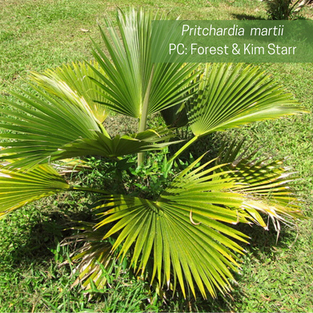It's Native Hawaiian Plant Month!
- Coconut Rhinoceros Beetle Response
- Apr 9, 2021
- 2 min read
Updated: Oct 1, 2021
We’re celebrating by highlighting some of the important palm species we work to protect.
Working in invasive species, you'd think our focus would be all about CRB all the time. Sometimes we step back to look at the bigger picture and what we're really working to protect. Unfortunately, we've recorded more death to native fan palms than coconut palms in Hawaii. While coconut rhinoceros beetle hasn’t reached all Hawaiian islands, accidental transport outside of Oʻahu poses a major threat to loulu everywhere.
In Hawaii, there are considered to be 22 endemic species of Pritchardia or loulu, representing a single colonizing lineage. The name Pritchardia honors William T. Pritchard, a 19th-century British consul to Fiji while the Hawaiian name loulu translates to “umbrella” and is named as such because the fronds were used to protect against sun or rain.
Starting with the oldest main Hawaiian island, we find Pritchardia remota. P. remota is a small palm restricted to cliff bases on Nihoa and Niʻihau. There are two known wild populations with only 680 individuals. This endangered species can also be found growing in cultivation.
Pritchardia minor is a medium-sized palm with a slender trunk. It can be found in mesic to wet forests on Kauaʿi island. The lower leaf surface is covered with soft yellow/grey or golden wooly hair. The small fruits called hāwane or wāhane bear a taste similar to coconut and were peeled and eaten by early Hawaiians.
Pritchardia martii or loulu hiwa is the most common species of pritchardia on Oʻahu. The lower surface of the leaf blades is silvery or with yellowish-brown scales. Although they are "common" and their status is secure, they are at a high risk of attack from coconut rhinoceros beetle as populations continue to spread throughout Oʻahu.
Maui Nui (especially Molokaʻi ) is home to some really beautiful Pritchardia! There's P. arecina, P. hillebrandii, and P. lowreyana just to name a few. With native loulu threatened by habitat loss, lack of natural pollinators, and climate change, introduced species like the coconut rhinoceros beetle pose a real threat to our special palms.
Pritchardia beccariana is found in emerging wet forests around 1,100-1,200 ft. elevations on Mauna Loa, Hawaii island. These tall palms can reach 16-19 m in height. Most often, we associate palms with low elevations and coastal regions. It's incredible how our endemic loulu have adapted to mesic-wet forest at a variety of elevations!
The fossil record shows that Pritchardia once dominated the Hawaiian landscape. Introduced rodents that feed on the fruit, quickly diminished populations. Our last remaining loulu are further threatened by the coconut rhinoceros beetle. Aside from being an important part of the Hawaiian ecosystem, loulu have immense cultural significance, too. The fronds or lau hāwane were used by early Hawaiians in roof thatching, making hats (papale), and fans. This Native Hawaiian Plant Month, we hope you take the time to appreciate all of the special endemic plants that make Hawaii unique
Sources:
Gustafson, Robert J., Derral R. Herbert, and Philip Rundel. Hawaiian Plant Life: Vegetation and Flora. Honolulu: University of Hawaii Press, 2014.
http://palmpedia.net






























Comments